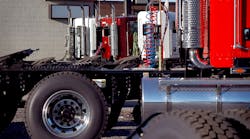We are all reading FleetOwner because we want to know what is next and what others are doing that may be better than what I am doing. The age-old question is, “Am I best in class or worst in class?”
Every day, for-hire carriers go to work tirelessly looking for ways to reduce operating costs to increase margin. Transportation assets are revenue generators, and each asset has its own profit-and-loss statement. Historically, operating costs have been consistent and fleets have been able to model the year-over-year cost increases, allowing them to make the critical “keep-or-replace” decisions for their assets.
Technological advancements accelerate every year. The financing of new technologies is growing more complex and will continue to do so for the foreseeable future.
Hard assets are not as easy to upgrade as software programs. Hard assets still must operate in the real world and haul freight. How are we going to change our thinking on financing to help us avoid technological obsolescence?
Having portions of your fleet in each phase of emerging technology is key. You cannot just flip a switch and change your entire fleet. In addition to a phased replacement approach, you will need to rethink your financing structures and allow for more flexibility.
This is not a time for a one-size-fits-all approach. The days of a five-year TRAC lease to 25% are long gone. Residual values of some of the new technologies will be very hard to establish, and you do not want to be standing alone when it comes to disposing of a potentially obsolete asset.
Choosing your technology—and more importantly, the right manufacturer—is critical. New questions like, “Are the batteries upgradable?” will drive lifecycle and operating cost considerations. Maintenance training and diagnostic equipment will transform and come with considerable costs that must be factored into the TCO equation. As fuel choice changes, just as with power plants, cost, and availability drive energy decisions.
We must consider more than the cost of the truck alone.
The future is bright, and I am very excited about the prospects of a cleaner, more sustainable, and efficient future. Drivers will appreciate our investments and willingness to prioritize their safety. Financing the future will be a critical component, and our models will need to change and adapt to accommodate the next new thing.
Patrick Gaskins, SVP of Corcentric Fleet Solutions, oversees both sales and operations for the company's fleet offerings. Gaskins joined the company in 2010, bringing more than 30 years of experience as a financial services professional in the transportation industry. He leads a team that works with a supply base of more than 160 manufacturers to help the country’s largest fleets manage all aspects of their fleet operations and fleet-related spend.




